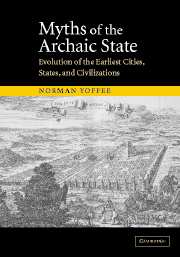Book contents
- Frontmatter
- Contents
- List of figures
- List of tables
- INTRODUCTION
- 1 THE EVOLUTION OF A FACTOID
- 2 DIMENSIONS OF POWER IN THE EARLIEST STATES
- 3 THE MEANING OF CITIES IN THE EARLIEST STATES AND CIVILIZATIONS
- 4 WHEN COMPLEXITY WAS SIMPLIFIED
- 5 IDENTITY AND AGENCY IN EARLY STATES: CASE STUDIES
- 6 THE COLLAPSE OF ANCIENT STATES AND CIVILIZATIONS
- 7 SOCIAL EVOLUTIONARY TRAJECTORIES
- 8 NEW RULES OF THE GAME
- 9 ALTERED STATES: THE EVOLUTION OF HISTORY
- Acknowledgments
- References
- Index
- References
References
Published online by Cambridge University Press: 22 September 2009
- Frontmatter
- Contents
- List of figures
- List of tables
- INTRODUCTION
- 1 THE EVOLUTION OF A FACTOID
- 2 DIMENSIONS OF POWER IN THE EARLIEST STATES
- 3 THE MEANING OF CITIES IN THE EARLIEST STATES AND CIVILIZATIONS
- 4 WHEN COMPLEXITY WAS SIMPLIFIED
- 5 IDENTITY AND AGENCY IN EARLY STATES: CASE STUDIES
- 6 THE COLLAPSE OF ANCIENT STATES AND CIVILIZATIONS
- 7 SOCIAL EVOLUTIONARY TRAJECTORIES
- 8 NEW RULES OF THE GAME
- 9 ALTERED STATES: THE EVOLUTION OF HISTORY
- Acknowledgments
- References
- Index
- References
- Type
- Chapter
- Information
- Myths of the Archaic StateEvolution of the Earliest Cities, States, and Civilizations, pp. 236 - 267Publisher: Cambridge University PressPrint publication year: 2005



